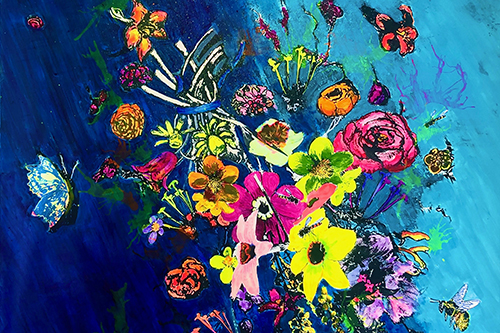'Displays Decoded': the multi-sensory language of flowers, will enable visitors to interact with the natural world in a unique way. The original artwork is by artist Alex Hirtzel, who has collaborated with University behavioural ecologist Dr Dave Lawson and colleagues in the School of Biological Sciences.
At a time when insect populations continue to decline, recent research by Bristol scientists, and led by Dr Lawson, has revealed previously undiscovered ways in which pollinators are attracted to and interact with plants, which are collectively known as 'sensory modalities'.
Through interactive sculptures, ultra-violet prints and heat sensitive materials, Alex’s artwork demonstrates some of the principle modalities: scent, UV light and colour patterns, static attraction and the cellular structure of the flowers themselves. Her work re-constructs 17th century Dutch flower paintings from the Broughton Collection at the Fitzwilliam Museum in Cambridge in a series of prints called 'Tipping Point', with vases toppling over to reflect today's global ecological crisis.
Other aspects of her work are more interactive, and visitors to the Garden will have the opportunity to experience for themselves how bees and other pollinators sense static from flowers, or are affected by a flower's scent.
Alex Hirtzel speaking about the exhibition said: "COVID-19 has made me rethink how to present ideas to a wide range of audiences and I chose to use augmented reality (AR) as a medium to further express the scientific storytelling and need for playful interaction."
Dr Dave Lawson added: "Certain aspects of floral displays are obvious to us as humans, such as scent and vision, but there are many avenues of communication employed by flowering plants that are hidden to us. It’s so exciting to be working alongside Alex Hirtzel and the Botanic Garden on a project that reveals these hidden facets of floral displays to a wider audience."
Inspired by Dr Lawson's research, which focuses on hidden aspects of floral displays and the effects that these display components have on foraging pollinators, Alex has created multimedia artwork that highlights how a bee visualises and interacts with flowers.
In these latest series, Alex uses materials that require interaction in order to experience the unseen world of the bee. Working with fluorescent paints the colour is very strong and is made to represent how a bee sees a flower. An activity that the artwork needs by the viewer is therefore a metaphor for being involved. Alex wishes the viewer to take a role actively ensuring that bees are at the core of a natural and healthy future.
Nick Wray, Curator of the Botanic Garden, said: "After not being able to hold any events at the Botanic Garden for over a year due to the COVID-19 pandemic, we are really excited to be hosting this exhibition and welcoming visitors back again.
"We have been working very closely with Alex and Dave, and the exhibition will allow people to experience the complex and multi-layered ways by which pollinators interact with flowers."
As an art historian, Alex is particularly interested in the 17th century, as it was a time of exploration with new flowers arriving in Holland as a result of trading and scientific discussion to understand how plants work. Nowadays new techniques and technologies have revealed how flowering plants act as advertising billboards to attract insects into them so that the flowers can reproduce.
This art and science exhibition will be of interest to enthusiasts of art, science, history, wildlife, new technology and all those interested in the natural environment. Visitors will also have the opportunity to enjoy a workshop with Alex and tours of the garden with behavioural ecologist, Dr Lawson.
The exhibition has been funded by the University of Bristol and Lottery Funding through Arts Council England.
'Displays Decoded': the multi-sensory language of flowers at the University of Bristol Botanic Garden, The Holmes, Stoke Park Road, Stoke Bishop, Bristol BS9 1JG, will be open to the public from Tuesday 6 July to Thursday 30 September 2021 from 10 am until 4.30 pm, seven-days-a-week, including bank holidays.
Admission: Adults: £5, (£7 with glasshouses open) Free to children under 18, Friends of the garden, University staff and all students. Tickets must be booked in advance via the University online shop.
